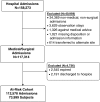Post-Acute Care Use and Hospital Readmission after Sepsis
- PMID: 25751120
- PMCID: PMC4590016
- DOI: 10.1513/AnnalsATS.201411-504OC
Post-Acute Care Use and Hospital Readmission after Sepsis
Abstract
Rationale: The epidemiology of post-acute care use and hospital readmission after sepsis remains largely unknown.
Objectives: To examine the rate of post-acute care use and hospital readmission after sepsis and to examine risk factors and outcomes for hospital readmissions after sepsis.
Methods: In an observational cohort study conducted in an academic health care system (2010-2012), we compared post-acute care use at discharge and hospital readmission after 3,620 sepsis hospitalizations with 108,958 nonsepsis hospitalizations. We used three validated, claims-based approaches to identify sepsis and severe sepsis.
Measurements and main results: Post-acute care use at discharge was more likely after sepsis, driven by skilled care facility placement (35.4% after sepsis vs. 15.8%; P < 0.001), with the highest rate observed after severe sepsis. Readmission rates at 7, 30, and 90 days were higher postsepsis (P < 0.001). Compared with nonsepsis hospitalizations (15.6% readmitted within 30 d), the increased readmission risk was present regardless of sepsis severity (27.3% after sepsis and 26.0-26.2% after severe sepsis). After controlling for presepsis characteristics, the readmission risk was found to be 1.51 times greater (95% CI, 1.38-1.66) than nonsepsis hospitalizations. Readmissions after sepsis were more likely to result in death or transition to hospice care (6.1% vs. 13.3% after sepsis; P < 0.001). Independent risk factors associated with 30-day readmissions after sepsis hospitalizations included age, malignancy diagnosis, hospitalizations in the year prior to the index hospitalization, nonelective index admission type, one or more procedures during the index hospitalization, and low hemoglobin and high red cell distribution width at discharge.
Conclusions: Post-acute care use and hospital readmissions were common after sepsis. The increased readmission risk after sepsis was observed regardless of sepsis severity and was associated with adverse readmission outcomes.
Keywords: critical care; emergency department use; hospital readmission; infection; sepsis.
Figures
Comment in
-
Untangling Health Trajectories among Patients with Sepsis.Ann Am Thorac Soc. 2015 Jun;12(6):796-7. doi: 10.1513/AnnalsATS.201503-134ED. Ann Am Thorac Soc. 2015. PMID: 26075553 Free PMC article. No abstract available.
Similar articles
-
The Relationship Between Index Hospitalizations, Sepsis, and Death or Transition to Hospice Care During 30-Day Hospital Readmissions.Med Care. 2017 Apr;55(4):362-370. doi: 10.1097/MLR.0000000000000669. Med Care. 2017. PMID: 27820595
-
Variation in Postsepsis Readmission Patterns: A Cohort Study of Veterans Affairs Beneficiaries.Ann Am Thorac Soc. 2017 Feb;14(2):230-237. doi: 10.1513/AnnalsATS.201605-398OC. Ann Am Thorac Soc. 2017. PMID: 27854510 Free PMC article.
-
Association Between Index Hospitalization and Hospital Readmission in Sepsis Survivors.Crit Care Med. 2016 Mar;44(3):478-87. doi: 10.1097/CCM.0000000000001464. Crit Care Med. 2016. PMID: 26571185
-
Relationship between insurance and 30-day readmission rates in patients 65 years and older discharged from an acute care hospital with hospice services.J Hosp Med. 2016 Oct;11(10):688-693. doi: 10.1002/jhm.2613. Epub 2016 May 25. J Hosp Med. 2016. PMID: 27222206 Review.
-
Functional status before and during acute hospitalization and readmission risk identification.J Hosp Med. 2016 Sep;11(9):636-41. doi: 10.1002/jhm.2595. Epub 2016 Apr 30. J Hosp Med. 2016. PMID: 27130176 Review.
Cited by
-
Factors Associated with 30-day Unplanned Readmissions of Sepsis Patients: A Retrospective Analysis of Patients Admitted with Sepsis at a Community Hospital.Cureus. 2019 Jul 10;11(7):e5118. doi: 10.7759/cureus.5118. Cureus. 2019. PMID: 31523549 Free PMC article.
-
Surviving sepsis campaign: international guidelines for management of sepsis and septic shock 2021.Intensive Care Med. 2021 Nov;47(11):1181-1247. doi: 10.1007/s00134-021-06506-y. Epub 2021 Oct 2. Intensive Care Med. 2021. PMID: 34599691 Free PMC article. No abstract available.
-
Predictors of 1-year mortality following discharge from the surgical intensive care unit after sepsis.Surgery. 2025 Mar;179:108808. doi: 10.1016/j.surg.2024.08.037. Epub 2024 Oct 10. Surgery. 2025. PMID: 39389823 Free PMC article.
-
Characteristics and One Year Outcomes of Melioidosis Patients in Northeastern Thailand: A Prospective, Multicenter Cohort Study.Lancet Reg Health Southeast Asia. 2023 Feb;9:100118. doi: 10.1016/j.lansea.2022.100118. Epub 2022 Nov 25. Lancet Reg Health Southeast Asia. 2023. PMID: 36570973 Free PMC article.
-
Blood count derangements after sepsis and association with post-hospital outcomes.Front Immunol. 2023 Feb 28;14:1133351. doi: 10.3389/fimmu.2023.1133351. eCollection 2023. Front Immunol. 2023. PMID: 36936903 Free PMC article.
References
-
- Angus DC, van der Poll T. Severe sepsis and septic shock. N Engl J Med. 2013;369:840–851. - PubMed
-
- Gaieski DF, Edwards JM, Kallan MJ, Carr BG. Benchmarking the incidence and mortality of severe sepsis in the United States. Crit Care Med. 2013;41:1167–1174. - PubMed
-
- Kaukonen KM, Bailey M, Suzuki S, Pilcher D, Bellomo R. Mortality related to severe sepsis and septic shock among critically ill patients in Australia and New Zealand, 2000–2012. JAMA. 2014;311:1308–1316. - PubMed
-
- Rivers E, Nguyen B, Havstad S, Ressler J, Muzzin A, Knoblich B, Peterson E, Tomlanovich M Early Goal-Directed Therapy Collaborative Group. Early goal-directed therapy in the treatment of severe sepsis and septic shock. N Engl J Med. 2001;345:1368–1377. - PubMed
Publication types
MeSH terms
Substances
LinkOut - more resources
Full Text Sources
Medical




